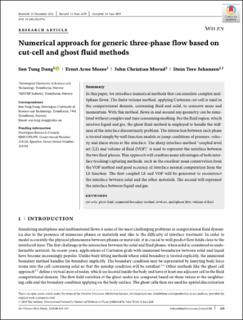| dc.contributor.author | Dang, Son Tung | |
| dc.contributor.author | Meese, Ernst A. | |
| dc.contributor.author | Morud, John | |
| dc.contributor.author | Johansen, Stein Tore | |
| dc.date.accessioned | 2020-06-12T05:51:45Z | |
| dc.date.available | 2020-06-12T05:51:45Z | |
| dc.date.created | 2020-01-08T13:37:30Z | |
| dc.date.issued | 2019 | |
| dc.identifier.citation | International Journal for Numerical Methods in Fluids. 2019, 91 (9), 419-447. | en_US |
| dc.identifier.issn | 0271-2091 | |
| dc.identifier.uri | https://hdl.handle.net/11250/2657794 | |
| dc.description.abstract | In this paper, we introduce numerical methods that can simulate complex multiphase flows. The finite volume method, applying Cartesian cut‐cell is used in the computational domain, containing fluid and solid, to conserve mass and momentum. With this method, flows in and around any geometry can be simulated without complex and time consuming meshing. For the fluid region, which involves liquid and gas, the ghost fluid method is employed to handle the stiffness of the interface discontinuity problem. The interaction between each phase is treated simply by wall function models or jump conditions of pressure, velocity and shear stress at the interface. The sharp interface method “coupled level set (LS) and volume of fluid (VOF)” is used to represent the interface between the two fluid phases. This approach will combine some advantages of both interface tracking/capturing methods, such as the excellent mass conservation from the VOF method and good accuracy of interface normal computation from the LS function. The first coupled LS and VOF will be generated to reconstruct the interface between solid and the other materials. The second will represent the interface between liquid and gas. | en_US |
| dc.language.iso | eng | en_US |
| dc.publisher | John Wiley & Sons | en_US |
| dc.relation.uri | https://onlinelibrary.wiley.com/doi/epdf/10.1002/fld.4758 | |
| dc.rights | Navngivelse 4.0 Internasjonal | * |
| dc.rights.uri | http://creativecommons.org/licenses/by/4.0/deed.no | * |
| dc.title | Numerical approach for generic three‐phase flow based on cut‐cell and ghost fluid methods | en_US |
| dc.type | Peer reviewed | en_US |
| dc.type | Journal article | en_US |
| dc.description.version | publishedVersion | en_US |
| dc.source.pagenumber | 419-447 | en_US |
| dc.source.volume | 91 | en_US |
| dc.source.journal | International Journal for Numerical Methods in Fluids | en_US |
| dc.source.issue | 9 | en_US |
| dc.identifier.doi | 10.1002/fld.4758 | |
| dc.identifier.cristin | 1768588 | |
| dc.relation.project | Norges forskningsråd: 244386 | en_US |
| dc.relation.project | Norges forskningsråd: 234126 | en_US |
| dc.description.localcode | This is an open access article under the terms of the Creative Commons Attribution License, which permits use, distribution and reproduction in any medium, provided the original work is properly cited. | en_US |
| cristin.ispublished | true | |
| cristin.fulltext | original | |
| cristin.qualitycode | 1 | |

